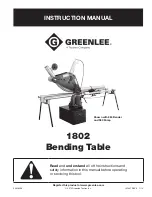
Page 11
Electronic Feedback Circuitry (EFC)
Your tool is equipped with a internal electronic
feedback system that provides a "soft start", which
will reduce the stresses that occur from a high
torque start. The system also helps to keep the
pre-selected rotating speed virtually constant
between no-load and load conditions.
Set the speed indicator to fit the job; to achieve the
best job results when working with different mate-
rials, the speed of the Rotary Tool should be
regulated. Model 398-49 Rotar y Tool has an
integral speed control.
An external speed control
should never be used with this
tool.
To select the right speed for each job, use a
practice piece of material. Vary speed to find the
best speed for the accessory you are using and the
job to be done.
NOTE: Speed is affected by voltage changes. A
reduced incoming voltage will slow the RPM of the
tool, especially at the lowest setting. If your tool
appears to be running slowly increase the speed
setting accordingly.
Digital Speed Selector Switch
Your rotary tool features a digital speed selector
switch which displays an L.C.D. reading of the tool’s
RPM. The speed can be selected from 5.000 RPM to
33.000 RPM in 1.000 RPM increments by simply
depressing the positive or negative buttons on the
switch.
TO TURN TOOL "ON": slide ON/OFF switch to the
"ON" position.
TO TURN TOOL "OFF": slide ON/OFF switch to the
"OFF" position.
TO INCREASE SPEED: depress button with + sign.
TO DECREASE SPEED: depress button with - sign.
Needs for Slower Speeds
Certain materials, however, (some plastics, for ex-
ample) require a relatively slow speed because at
high speed the friction of the accessory generates
heat and causes the plastic to melt.
Slow speeds (15.000 RPM or less) usually are best
for polishing operations employing the felt polishing
accessories. They may also be best for working on
delicate projects as “eggery” work, delicate wood
car ving and fragile model parts. All brushing
applications require lower speeds to avoid wire
discharge from the holder.
Higher speeds are better for carving, cutting, routing,
shaping, cutting dadoes or rabbets in wood.
Hardwoods, metals and glass require high speed
operation, and drilling should also be done at high
speeds.
The point to remember is this: You can do the great
majority of work at its regular speed of 33.000 RPM.
But for certain materials and types of work, you need
slower speeds — which is the reason the variable
speed models were developed.
To aid you in determining the optimum operational
speed for different materials and different
accessories, we have constructed a series of tables
that appear on page 13, 14, and 15. By referring to
these tables, you can discover the recommended
speeds for each type of accessory. Look these tables
over and become familiar with them.
Ultimately, the best way to determine the correct
speed for work on any material is to practice for a
few minutes on a piece of scrap, even after referring
to the chart. You can quickly learn that a slower or
faster speed is more effective just by observing what
happens as you make a pass or two at different
speeds. When working with plastic, for example,
start at a slow rate of speed and increase the speed
until you observe that the plastic is melting at the
point of contact. Then reduce the speed slightly to
get the optimum working speed.
Some rules of thumb in regard to speed:
1. Plastic and materials that melt at low
temperatures should be cut at low speeds.
2. Polishing, buffing and cleaning with a wire brush
must be done at speeds below 15.000 RPM to
prevent damage to the brush.
3. Wood should be cut at high speed.
4. Iron or steel should be cut at top speed if using
tungsten carbide accessory, but at slower speeds
if using high speed steel cutters. If a high speed
steel cutter starts to chatter — this normally
means it is running too slow.
5. Aluminum, copper alloys, lead alloys, zinc alloys
and tin may be cut at various speeds, depending
on the type of cutting being done. Use paraffin or
other suitable lubricant on the cutter to prevent
the cut material from adhering to the cutter teeth.
Increasing the pressure on the tool is not the answer
when it is not cutting as you think it should. Perhaps
you should be using a different cutter, and perhaps
an adjustment in speed would solve the problem. But
leaning on the tool seldom helps.
Operating Speeds for Accessories
Use only Dremel Tested, High Performance Accessories.
CAUTION
!
DM 2610934164 05-06 10/6/06 8:41 AM Page 11










































